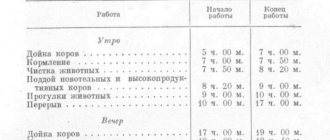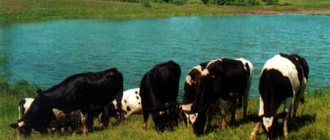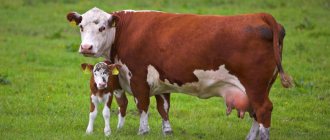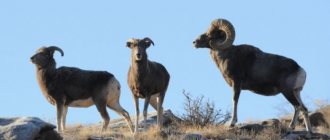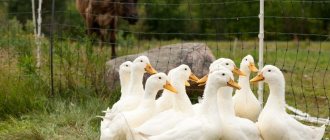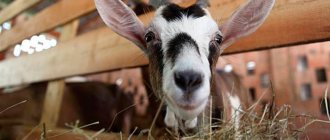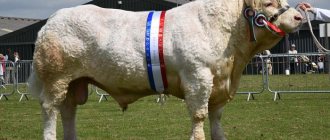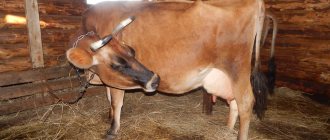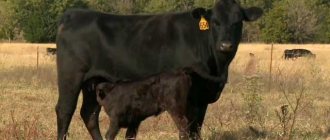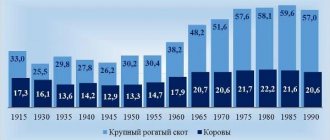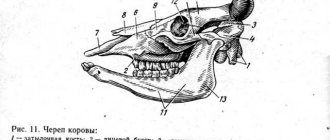published: 18. 12 . 2019
author: Vitaly Shibarshin
From this article you will learn:
- What are the types of cow feed?
- What are the features of feeding cows in summer?
- What should a cow's feeding diet consist of during the winter?
- What should a dairy cow's diet be like?
- How to create a diet for a beef cow
- What to consider when planning a diet for a pregnant cow
- How to feed young animals correctly
- What causes cow diseases and how to prevent it
- Is there any benefit to feeding cows the same way?
- Why is glucose good for feeding cows?
- What rules should you follow when preparing the correct diet for feeding cows?
Balanced feeding of cattle is the main condition for its high productivity. The diet of cows, enriched with minerals and nutrients, helps to increase milk production, improve the quality of milk and meat, and reduce the level of disease in animals. Therefore, to obtain high returns, it is very important to be able to organize complete feeding, correctly calculate the portion and introduce new components into it in a timely manner. You will learn how to do this from this article.
Basics of proper diet for cows in summer and winter
The main diet of cows of all ages and breeds (except newborn calves) consists of green and hay masses. Other types of food are complementary foods.
Diet of cows in summer
Summer is called grazing season for cattle. The diet of cows in the summer consists of green feed. Farmers organize daily stay of animals on pastures. On pastures, cows receive a sufficient amount of all the necessary green feed, and return home only at night to receive a portion of complementary food and spend the night.
There is another way of feeding - the farmer independently prepares green food for animals. But since one adult animal can eat up to 70 kg of such food per day, this method is a more expensive technology.
In the summer months, the diet of cows is supplemented with complementary foods, which include:
- seasonal vegetables and root vegetables;
- melons;
- feed;
- vegetable tops;
- food waste.
Diet of a cow in winter
The main diet of cows in winter consists of dry feed - hay and straw. To ensure adequate feeding, animals are additionally given root crops, silage, and mixed feed. Farmers produce hay themselves or purchase it from suppliers. One adult cow eats up to 15–20 kg of dry food per day.
Important! When purchasing hay, you need to check its quality. To do this, it is recommended to take a sample from under the upper layers of a bale or stack, carefully examine for the presence of diaper rash, pay attention to the composition, color, and smell. It is better to purchase dry food from trusted and conscientious suppliers.
In winter, the cow's daily diet consists of roughage. Therefore, when feeding, it is important that the basis of daily portions consists of quality hay and grass cuttings. Bulky and coarse hay of low quality is difficult to digest. Dairy cows can consume it in sufficient quantities when dry. The presence of 1.5–2 kg of low-grade hay per 100 kg of dry food is acceptable.
High-grade quality hay is beneficial for cattle. It contains a lot of proteins, minerals and vitamins.
A cow's daily diet must contain feed additives: root crops, silage, melons. Among root vegetables, the most suitable as complementary foods are: sugar and semi-sugar beets, potato tubers, and carotene-rich red carrots.
The volume of succulent feed additives in a cow’s daily diet must be gradually increased to a ratio of 10 kg (or higher) per 100 kg of high-grade hay weight. For pregnant dry animals, the increase is up to 4-5 kg per day of succulent agricultural products.
To ensure adequate nutrition for cattle, concentrates or complete feed are included in the daily ration. With normal milk yield their share is 300–350 g per 1 kg of milk, and with high milk yield it is increased to 500 g per 1 kg of milk. For better feeding of the cow, fish meal is added at a rate of 300–500 g per day.
Types of feed
Diversity in the diet of cattle helps eliminate deficiencies of microelements, energy and vitamins. Also, different types of feed play an important role in increasing milk yield or weight gain. Another advantage of using a varied diet is the reduction in cost of feed.
Rough
This type of food includes plant-based foods with low moisture content and high fiber content. First of all, this is the most common feed for cattle: hay, as well as straw, branches and haylage.
High-quality hay is best suited for animals, as it takes into account the characteristics of rumen digestion.
Hay in the structure of a cow’s diet reaches 50% or more, depending on the physiological period, the direction of productivity and the growing technology used. The most complete from a nutritional point of view is cereal-legume hay. In its pure form, dry grass of cereals or legumes is rarely used, since the first type is much poorer in protein, vitamins and microelements, and legume hay easily spoils and greatly loses nutritional value during storage.
Straw and twig feed are rarely found in cattle diets. They have low nutritional value, low sugar and protein content, and are deficient in most vitamins and microelements. To compensate, costs for concentrates and food additives are increasing. It is also recommended to treat the straw - liming, adding feed urea, malting and yeasting.
The most profitable preparation of roughage is haylage. To do this, dried grass is crushed and compacted into trenches and other containers to displace air. Under anaerobic conditions, dried and chopped plant matter is perfectly preserved and nutritional loss rarely exceeds 12%, which is significantly better than that of hay or silage.
Juicy
Plant foods with high (up to 90%) humidity. These are cooked (silage, combined silage) or ready-made (root crops, tubers, vegetables, fruits) products that contain a large amount of water and also have good nutritional and energy value.
During the process of making silage, more nutrients are retained. Due to natural preservation at humidity up to 75%, nutritional loss does not exceed 10-15%. Any green mass is used for ensiling - corn, legumes and cereals, forbs. Often crushed tuber crops (beets, carrots) are added with the green mass, but usually they are added before feeding along with concentrates - preparing combined silage. An important advantage of silage feed is its suitability for a feed dispenser. This allows you to mechanize and speed up the feeding process.
Cows can be fed raw potatoes; to do this, they must be carefully sorted and washed from dirt. Green potatoes (corned beef poisoning) affected by rot and mold are not allowed in the diet. To improve the nutritional value of the tubers, it is recommended to steam or ensile. The use of beets and carrots in the diet of cattle should be limited - in the first case there is a large amount of sugar, and in the second it can cause bitterness in the milk. It is advisable to increase the content of fodder beet in the diet if there is a lack of quality hay, especially when using straw.
Greens
These include cut grains, legumes and forbs, vegetable tops, and algae. This is a natural food in the summer, which makes fattening and milk production cheaper. The most profitable is the pasture type of housing, in which the cow eats green feed in the required quantity without staff intervention.
The main advantage of green food is its high content of vitamins and nutrients compared to canned food. In addition, high humidity classifies it as a dairy feed, which makes it possible to increase milk yield in cattle in the summer.
This diet also has its disadvantages. The waste quickly deteriorates, rotting occurs in its thickness, and the grass is easily infected with microfungi. Also, poisonous and harmful plants present in forbs retain their toxic effects to a greater extent without treatment.
Concentrates and additives
Feeds that eliminate the lack of most microelements and vitamins in the diet and increase its energy value. These include grain from legumes and cereals, mill waste and processing industry waste. Feed additives include mineral supplements (lick salt), meat meal, blood meal, milk, dairy products and waste, and molasses.
Feed concentrates are usually processed to improve their absorption by ruminants. For this purpose, flattening, crushing, germination or yeast are used. Compound feed is also often prepared - a mixture of grains and mill waste with food additives, vitamins, and microelements. They are prepared on the farm, taking into account the physiological state of the animal and its productivity.
Supplements also include growth stimulants. They are used during the fattening period of cattle and improve the digestion of feed and its absorption. Metabolism and muscle building increase.
Diet of a dairy cow
Preparing the correct diet for a cow can be a bit challenging. In order to correctly calculate the required amount of feed, you need to take into account all the details and make certain adjustments.
To calculate a cow's daily diet, we first take the average food consumption standards for one cow per day. Then the average statistical indicator must be adjusted. The menu and amount of feed directly depends on the milk supply of the cow (milk or dry), the breed of the animal (meat or dairy), its physical characteristics: weight, age and general condition.
Basic moments
The diet of dairy cows differs significantly from the feeding standards of beef cattle. Do not forget that the amount of milk yield and its dynamics directly depends on the type and quality of feed that the animal consumes. For dairy herds, the menu must include succulent milk feeds:
- fresh grass;
- root vegetables: carrots, beets, Jerusalem artichoke;
- vegetables: pumpkin, squash.
To increase milk yield, in addition to succulent milk feed, it is important to provide the necessary drinking regime for the cow. The volume of water for a dairy cow in winter is 35–40 liters; the animal can drink up to 15 times a day. At the same time, a dry cow consumes water up to five times a day in a volume of 12–15 liters.
For a farmer, it is important not only the quantity of milk received from one cow, but also its quality. To increase the quality indicators of dairy products, grain and its derivatives, as well as special feed additives enriched with vitamins, are additionally introduced into the diet of a dairy cow.
Before you begin to compile a diet for a dairy cow, you need to clearly divide all the animals in the herd into groups. One category includes individuals that have approximately the same physical indicators: weight, age and general condition. We must not forget that the amount of feed required for each dairy cow should be calculated taking into account its daily milk yield.
Features of feeding at different periods of life
The life cycle of cattle producing milk consists of several repeating stages:
- dead wood;
- calving;
- lactation.
The cow should receive the most intensive and balanced nutrition in the first and last quarter of pregnancy. Deviations from nutritional norms negatively affect the development of the fetus and the milk production of the cow.
In the first months of pregnancy, the formation of the calf's internal organs begins. During this period, the diet of pregnant cows should be balanced. The embryonic development of the calf in the first 2 months is very slow, there is almost no weight gain, but the animal must receive all the necessary vitamins and minerals in sufficient quantities. One of the farmer’s tasks is to fatten the animal at the beginning of the dry period until the layer of back fat reaches 25 mm.
Drying for cows begins 45-60 days before calving. Depending on the breed, the degree of fatness of the animal and the time of year, the increase in live weight in dead wood reaches 0.7-1 kg. If the cow's daily diet is disrupted during the dry period, calves are more susceptible to infectious diseases.
Attention! Violation of feeding recommendations during the dry period leads to high mortality among calves. Up to 20% of young animals die from infections, and the farmer receives up to 500 kg of milk per cow per lactation.
Lack of dry feeding reduces the fertility of cows by 2 times, however, excessive feeding does not have positive consequences. Obesity in cows is fraught with difficulties during the calving process.
At the beginning of lactation, animals experience an urgent need for additional sources of energy, and with a lack of nutrition, a loss of live weight is observed. During the first 2-3 months of lactation, animals are given a feed additive of propylene glycol (up to 4% in feed). This measure will make up for the lack of energy and prevent the development of ketosis - acetonemia.
A lactating cow needs to be given feed rich in vitamins:
- E;
- B-carotene;
- D;
- thiamine;
- nicotinic and folic acids.
These vitamins affect the reproductive function of animals and the subsequent survival of young animals.
The importance of balancing the diet for dairy cows is undeniable, and in order to properly organize the animals’ nutrition, you should use the available nutrition standards.
Beef cow diet
The diet of beef cows is structured differently. Cattle of beef breeds are kept in a free-stall manner. With this content there are no restrictions on the consumption of green and roughage. To feed animals, special fattening technologies are used using silage, green feed, pulp, stillage and various feed mixtures.
The basis of the diet of beef cows is green grass and hay obtained from pastures and pastures.
As an addition, the menu includes root vegetables, seasonal vegetables and fruits, feed and concentrates. To obtain marbled beef and fatten livestock to the required standards, the daily diet of cows is supplemented with combined products: grain crops, cake, bran, meal, meat-bone and fish meal. One animal consumes up to 400 g of combined feed per day.
Although compound feed increases the meat productivity of cattle, it is not recommended to include more than 400 g of such feed per day in a cow’s diet. Excessive consumption of combined feeds by animals leads to digestive disorders.
- If cattle are kept for fattening in a stall on a leash, then feeding is carried out 2-3 times a day, at equal time intervals.
- The most cost-effective technology for fattening cattle is fattening on pasture. But this method is used mainly in the warm season and is most common in areas where there is a good food supply: in the Voronezh and Rostov regions, Stavropol and Krasnodar territories.
Both methods described above are well suited for fattening animals. The choice of feeding option for beef cows depends on the conditions of their keeping and the capabilities of the farmer. But in any case, the main component in the diet of beef cattle is combined feed rich in proteins. They promote rapid weight gain.
- Beef cows must graze for at least 12-13 hours a day.
Scientists from the Astrakhan region have proven through experimental research that better fattening results can be achieved if you increase the grazing time by at least two hours. Especially at the beginning of the season, in May and June. The most significant result of weight gain is 2 kg per day, and the total weight gain per head of cattle was 40% and 70% in young animals.
Sometimes cows begin to “gnaw” their feeders or chew manure. This comes from a lack of minerals in the diet. Green food does not contain enough minerals necessary for animal life. Therefore, a cow’s daily diet should include at least 40 g of mineral feed containing 15 g of calcium, 12 g of phosphorus, and 13 g of table salt. Moreover, the amount of salt during the summer should gradually increase to 2 kg. They leave it in various places in the pen.
- Particular attention should be paid to the watering hole.
Although one cow on grazing along with grass receives from 35 to 40 liters of water per day, in order to fully satisfy the animals’ need for water, it is necessary to ensure an optimal drinking regime - water at least three times a day.
- The process of fattening beef cows is divided into two stages depending on the age of the animal: the first stage lasts from 1 to 6 months, the second stage - from 6 months and older.
Up to six months, the diet of young animals of both sexes (bulls and heifers) is no different, and weight gain is at the same level. After 6 months, the bulls and heifers are separated from each other.
Adult, mature animals need 80 g of protein per feed unit. But to ensure the desired results of fattening beef cows, it is better to be guided by the standards presented in the table. Recommended values for preparing the diet for stalled cows in the winter:
The table shows average data that can be used to create the correct diet for fattening cows. To achieve better results, it is recommended to add 500 g of concentrates or 700–800 g of molasses to animal food once a day.
In the warm season, the basis of the cattle diet is fresh grass. This allows you to reduce the consumption of root crops and vegetables, which serve as a source of nutrients and vitamins in the winter and are added to the diet of cows in large quantities. Keeping a beef cow on pasture will cost the farmer much less.
But it is not always possible to provide grazing for a cow even in summer. If an animal is kept in a stall during the warm season, then the basis of its diet is cut green grass, which is placed in a feeder. In this case, green food makes up at least 50–70% of the total daily intake.
Feed components for lactating cows
Proteins are building materials for cells and play a key role in metabolic processes. They include proteins and amides (easily digestible intermediate products). With proteins, the body receives 10 essential amino acids, which it cannot synthesize on its own or produces in insufficient quantities. Animals especially need:
- in lysine,
- methionine,
- tryptophan,
- threonine.
A lack of essential amino acids in the diet leads to a slowdown in metabolism, hormonal disorders, decreased immunity and reproductive function.
Carbohydrates are the main components in the nutrition of farm animals, affecting the synthesis of DNA and RNA and participating in the formation of immunity. They enter the body in the form of:
- starch,
- sugars,
- fiber.
Carbohydrates are responsible for the accumulation of nutrients in cells and the formation of ATP. The energy level and the functioning of the digestive system depend on their quantity. For animals, especially ruminants, fiber is of great importance, as it maintains normal stomach acidity and stimulates intestinal motility.
Fats are a source of energy and nutrient reserves. They are necessary for animals for normal cellular metabolism. Unsaturated fats have a positive effect on the functioning of the cardiovascular system, while saturated fats have a positive effect on gaining muscle mass and fat, as well as their taste.
Minerals are found in small quantities in all cells. With their shortage, metabolic processes are inhibited and the general condition of animals worsens. The group of macroelements includes:
- calcium - bone tissue material;
- phosphorus is an element of lipid and carbohydrate metabolism;
- sodium regulates osmotic pressure;
- chlorine stimulates digestion;
- potassium is necessary for stable heart function and animal growth;
- magnesium is a component of lung tissue;
- sulfur is needed for normal growth of fur, feathers, hooves and horns.
Microelements are components of enzymes and hormones and in their composition have a significant impact on metabolic processes. The most important of them include iron, copper, cobalt, iodine, and selenium.
Vitamins, like minerals, are required in small quantities, but are involved in all metabolic processes. Although they are organic compounds, most of them cannot be synthesized by animals and must be obtained through food. When calculating the dosage, it is important to take into account the properties of vitamins. Fat-soluble substances (A, D, E, K) tend to accumulate in the liver and adipose tissue. As a result, the likelihood of hypervitaminosis increases. Water-soluble (group B, C) are quickly excreted in the urine, so animals are more likely to be deficient in them.
Enzymes in the feed are necessary for better digestibility of the product. They break down complex compounds into simpler ones, speeding up their digestion. Enzymes also affect coat color.
Our company produces a series of premixes for lactating cows.
| MEGAPRO | OPTILAC | NORMILAC | Optilak MAXILAC |
| Recommended for balancing the diet with vitamins, microelements and introducing additional amounts of high-quality protein in herds with a productivity of up to 6000 liters per head per year. | Developed according to Cornell University feeding standards from 2022, taking into account DMI (dry matter intake) of 18 kg per head per day. | It is administered from the beginning of lactation until the start of 150 - 200 grams per head per day. Dry matter intake is up to 22 kg per head per day. | Designed to meet dry matter intake of up to 25 kg per head per day. |
The microbiological synthesis method makes it possible to obtain the missing vitamins in the required concentration to enrich the main feed.
The possibility of long-term storage of the product is achieved by adding components that prevent caking and the development of harmful microorganisms.
Balanced feed supplies the cattle with all necessary components.
Compound feed for dry cows
The nutrient content of formulations for adult animals depends on the feeding period. During dry periods, cows require special care. This determines how healthy the fetus will be and how the mother’s body will replenish its supply of nutrients for the next lactation period.
During the dry period, the cow should receive approximately 70% bulk nutrition, as well as about 30% concentrated complementary foods. The diet includes sugar, large amounts of fiber and starch, which contribute to rapid weight gain and slower metabolism. At the 2nd stage of dead wood, premixes and BVMK are used to replenish the loss of proteins and minerals (sodium, calcium, phosphorus, magnesium, sulfur, iron, iodine, zinc, manganese). This makes it possible to prevent the exhaustion of cows after calving and milking and to extend their productive period.
| MEGAPRO OPTICAB 8 | MEGAMIX OPTICAB | MEGAMIX MAXICAB | MEGAMIX OPTIDRAY |
| Recommended for balancing the diet of vitamins, microelements and protein in the diets of dry cows. When entering, pay attention to the cation-anion balance (CAB) in the second dry period and the overall protein level in the diet. | Optimal premix for dry cows with CAB = -1500. Dosage in the 1st phase - 150 g, in the 2nd - 200 g. | Improved premix for dry cows with CAB = -1500. | Designed to allow feeding in both phases of dry wood. KAB = 0 |
Advantages of MEGAMIX compound feeds
On average, dairy cows need 0.2–0.5 kg of feed per day for every liter of commercial milk. The exact figure is determined taking into account the weight, physical condition of a particular individual, lactation phase and the quality of the main feed. Meat breeds from the 3rd month of life need regular consumption of succulent feed. To increase the average daily weight gain in calves aged 2–3 months. they need to be given about 0.6 kg of grain fodder, and six-month-old animals - about 3.5 kg. For adults, the maximum portion of feed is 4 kg.
It is extremely difficult to independently produce and maintain complete, balanced formulations for all ages. If the livestock complex does not have specialized equipment, it is more advisable to buy ready-made feed. You can purchase finished products or order their production according to an individual recipe. We produce compound feed, BVMD and premixes for all ages and breeds of cattle. All our products are certified and their quality exceeds the requirements of GOST standards.
Diet of pregnant cows
The calf's health directly depends on the diet of pregnant cows. It is necessary to carefully think through all the components of the cow’s nutrition from the very beginning of pregnancy. It is very important that the animal, along with food, receives all the nutrients and vitamins necessary to maintain the normal condition of the cow itself and the development of its fetus.
- What should a pregnant cow's diet be like?
The diet of a pregnant cow should include highly nutritious foods that are easily digested by the body: bean hay, succulent feed (silage, root crops, grass), concentrates in small quantities.
Tip: It is very useful to include sugar beets in moderate quantities in the diet of pregnant cows. This root vegetable is added to feed to prevent udder diseases after calving.
Do not forget that during pregnancy a cow needs minerals, which are contained in bone meal, chalk, limestone, and table salt.
In the winter season, a pregnant cow requires food enriched with nutritional supplements and vitamins. Fish oil, feed yeast, and special vitamins should be added to the feed. In order to balance the main components of nutrients and protein, it is necessary to introduce bran and cake into the animal’s diet.
- How much feed to give to a pregnant cow?
The daily volume of feed for one pregnant cow is calculated in accordance with its body weight. The average daily intake is: 2-2.5 kg of roughage and 4-5 kg of succulent feed.
Various food additives and mineral supplements supplement the cow’s diet depending on its general physical condition and time of year. In winter, when green feed is reduced or absent, it is necessary to increase the amount of supplements.
- What is included in the diet of a pregnant cow?
At the very beginning of pregnancy, the cow's diet is varied, containing all types of feed. But over time, the diet changes.
The proportion of succulent feeds is gradually decreasing, being replaced with roughage and wet mash. To maintain the health of the cow, it is necessary to carefully monitor its condition and weight. Loss of body weight indicates complications that have arisen.
A cow's diet changes after calving. The feeding regimen and the amount of food consumed becomes normal. Sometimes, in order to activate the process of milk formation, the method of advanced nutrition is used.
Increased efficiency
There are two methods for monitoring the quality of feeding on farms - zootechnical and physiological; let's look at them using the example of an unbalanced diet.
The most common manifestation is ketosis. The disease is caused by a violation of fat, protein and carbohydrate metabolism.
The main causes of improper metabolism are:
- malnutrition;
- improper use of feed;
- insufficient carbohydrate content;
- too much silage;
- poor quality haylage.
The accompanying reason is hidden in the violation of hygienic conditions of detention.
Propionic acid is a warning factor for ketosis. This is a source of glucose that reduces the development of negative microflora in the cow’s gastric system. It is formed in the forestomach due to eating large amounts of concentrates and good hay.
How to feed a cow to improve feed absorption processes? Vegetable bitterness should appear in the animal’s gastrointestinal tract (physiological method). They are divided into aromatic and pure.
But for therapeutic purposes, both are used as taste irritants. They reflexively act on the animal through nerve cells, increasing the secretion of gastric juice. Fermentation activates digestion and appetite.
Vegetable bitters include:
- gentian (root);
- dandelion (root);
- trefoil (leaves).
Aromatic - calamus, wormwood, yarrow. Close to them are dill, cumin, anise. Regular salt is considered a good way to improve cow digestion.
Zootechnical methods for preventing ketosis include:
- systematically maintaining cleanliness in the feeders;
- free access to clean drinking water;
- a sufficient amount of good quality food.
Straw with mold, spoiled silage, good-quality haylage and sour pulp are unsuitable for feeding to highly productive cows. Overfeeding of certain types of food also has a bad effect on animals. For example, long-term feeding of the same type, silage or concentrate is undesirable.
The decline in lactation of a highly productive cow can also be caused by a lack of quality hay.
Therefore, it is important to monitor what and how much a cow eats per day. It is necessary to carry out a gradual change of feed and rations depending on the season. The transition period from housing to grazing should be at least two weeks. Changing food types, for example, from concentrated to bulky, should take 4-6 weeks.
Diet of young animals
In order for the calf to develop strong immunity and grow strong and healthy, it is necessary to feed the newborn with colostrum in the first hours of life. Over the next three days, the calf's diet consists of mother's milk, which is given at least six times a day. After this three-day period, the milk dosage is reduced to two liters, and the number of feedings is reduced to three times a day. This regime lasts for up to three weeks. After this time, the milk can be replaced with reverse milk, and the calf begins to be accustomed to “adult” feed. He is fed hay, grass, mash and mash based on skim milk and bran.
It is recommended to reverse feed dairy heifers for up to two months.
Feeding and housing
During the USSR period, it was primarily thanks to feeding that it was possible to maintain the productivity and health of cattle at a level.
This fattening period may vary in duration. This is due to several factors:
- age of individuals;
- conditions of detention;
- characteristics of the grass stand;
- walking technologies.
For example, adult animals of average fatness needed 50-70 days of walking, and young animals, provided that the grass was of high quality and in sufficient quantity, needed to be grazed for 110-120 days. With the early appearance of grass at an early stage of feeding, the weight of the animal could increase every day within 2 kg.
At the initial stage of keeping animals on pasture, they were gradually accustomed to staying at the walking site for 16 hours a day; over time, the duration of walking decreased to 9-12 hours. To feed livestock on the pasture, special above-ground storage facilities were built, which contained a sufficient amount of silage.
In the process of forming the livestock, animals of approximately the same weight, age and gender were selected. The number of individuals was determined by the size of the walking field. If there was open pasture, the herd could contain approximately 200 head of cattle.
When feeding, it is necessary to use a pen system. The pasture must be divided into fenced areas where the cattle are kept for a certain time, and it should also be taken into account that one pen can be used for a maximum of 5 days. After transferring the herd to a new pen, the remaining grass on the one already used must be mowed. When grazing in the last area is completed, the cows must again be transferred to the first paddock, where by this time young vegetation will have appeared.
Light canopies should be installed over the pens to help protect the animals from rain and bright sunlight. Feeders should be placed throughout the area to distribute additional feed and salt. Cows must be watered using transportable drinking bowls or from a nearby reservoir.
Regarding the housing during the stall period, at this time the animals are in barns, most often this happens in the autumn-winter period. Although some livestock farms keep livestock indoors all the time. Linked content has some advantages. This allows you to create a nutrition plan individually for each cow on the farm, taking into account its age characteristics, productivity, body weight and other indicators.
For feeding, they resort to the help of stationary or mobile feed dispensers. Otherwise, the work must be done manually. Each cow needs to be given a separate portion of feed, placing it in the feeder. In winter, the diet of such animals includes hay, fodder beets, fermented food and straw. When the spring-summer period begins, the livestock must certainly be given green grass and concentrates.
What causes cow diseases and how to prevent it
Academician V. Levchenko suggested that due to non-compliance with feeding standards, lack of starch and sugar in the diet of cows, an energy deficiency occurs. This leads to the development of multiple pathologies in cattle: rumen hypotension, hepatodystrophy, acidosis, ketosis.
Diseases often develop against the background of a diet that is oversaturated with proteins.
Proteins in the body of cattle are hydrolyzed by rumen microorganisms. Excessive amounts of butyric acid provoke problems and diseases in animals. The processes occurring in the forestomach of a cow contribute to the development of various diseases.
Soy protein is broken down very slowly in the body, so in a cow's rumen its breakdown period lasts a very long time. More healthy soybean meal is introduced into the diet of highly productive cows along with feed; its ratio is 1.5–2.0% of the total daily requirement. In terms of the duration of the splitting period, sunflower protein ranks second. In the shortest period of time, rapeseed protein breaks down. A balanced ratio of these three protein sources helps optimize the nitrogen balance in cattle.
When preparing a diet for cows, we must not forget about the mineral basis of cattle feed.
A large amount of minerals are excreted from the body of dairy cows every day along with milk.
In order for the animal’s body to be saturated with minerals in the required quantity, it is necessary to carefully control their share in the diet. A deficiency or excess of these nutrients in cattle nutrition negatively affects the absorption of important microelements.
Pathological risk factors and causes of disease development in highly productive cows:
- an excess of calcium in the diet of cows leads to a deterioration in the absorption of vital elements: copper, zinc, iodine;
- when an animal’s body is oversaturated with magnesium, calcium absorption decreases;
- lack of phosphorus leads to severe damage to the ovaries and causes infertility in female cattle;
- excess iron interferes with the absorption of zinc and leads to copper deficiency;
- if there is a lack of zinc in the diet of cows, the embryo does not take root in the uterus;
- with a lack of such important microelements as cobalt, manganese, copper, highly productive cows have a reduced ability to fertilize.
A properly formulated and balanced diet for cows ensures a regular supply of minerals, proteins, carotene and other biologically significant elements to the animal’s body. Only high-quality feed (hay, silage) contains all the necessary nutrients and microelements.
Allowed and prohibited products for cows
Feeding with granulated feed is now common; it increases the productivity of animals and allows for precise dosing of nutrients.
But it has disadvantages - feeding only granules will reduce the fat content and the total amount of milk. In addition, the cow's rumen will begin to function improperly.
It is useful to add feed to no more than 50% of the total nutritional value of the diet, giving it along with bulk feed or silage.
Extrusion processing allows you to obtain a nutritious and tasty product. With it, the cow will increase milk yield by 20-40%, the processed feed is almost completely digested. Feeding becomes easier and the nutritional quality of the food is not affected.
Is there any benefit to feeding cows the same type of diet?
Recently, Russian farmers have become widespread in the same type of feeding (mono-feeding) of dairy animals - the diet of cows remains the same throughout the year and does not depend on the season. To obtain high gains when organizing cattle nutrition using the same technology, you must adhere to the following rules:
- Corn, clover and other forage crops must be sown in large areas as early as possible.
- During the summer months, dairy cows should only be out grazing until lunchtime.
- In order for milk yield to increase, it is necessary to create stable conditions for animals with a constant diet.
It should be noted that the same type of cattle feeding technology does not contribute to achieving record milk yields. This diet for cows can be called anti-stress, since there is no sudden change in feed of different types, and productivity indicators remain constant throughout the year.
Monofeeding requires the obligatory inclusion of legumes and cereal-legume mixtures in the diet of cows, but it is not recommended to feed cattle too abundantly with sainfoin hay or plants of the legume family. It is better to associate them with silage. The daily diet of cows must include healthy vitamin supplements, feed mixtures and biologically significant microelements.
Some farmers who practice uniform feeding note that this technology does not allow using all the capabilities of highly productive cows. Obtaining high milk yields is facilitated by alternating winter and summer diets in accordance with specially developed schemes.
In regions where there is not enough pasture, cattle are kept in stalls year-round. This regimen is identical to the same type of feeding and is reflected in the level of lactation.
Pasture maintenance ensures a balanced diet for cows, high quality dairy products, and prevention of animal diseases. But in the absence of the necessary conditions for grazing livestock, monofeeding is considered an acceptable option.
Specifics of hay harvesting
The quality of dry grass harvested for the winter depends on the correct organization of haymaking:
- High-quality hay will be obtained if it is harvested early in the growing season. Young grasses are more nutritious, as they differ in foliage. The leaves account for 40-50% of vitamins and other microelements.
- Old plants have fewer leaves, their digestibility decreases, and more waste remains.
The grass cover changes very quickly. For each haymaking option, there are optimal harvest times. For leguminous grasses, this is the onset of budding, and for cereals, this is the beginning of the appearance of an ear. With flowering comes a transition period. Harvesting results in low nutrient content in the hay.
The determining factor for choosing the time is dry and clear weather. When there is rain or dew, the drying of the hay increases, which also leads to loss of nutrients.
Tedding helps reduce the moisture content of hay. There are special mechanical roller rakes for the job.
The color of the hay indicates its quality. It is believed that properly dried grass is green. However, the shades may be different:
- cereals - gray greens;
- sour herbs - intense greens;
- legumes - brown greens;
- Alfalfa is a vibrant green.
If the technological conditions for mowing and storing are violated, the hay will:
- whitish (lying in the sun for a long time);
- light yellow (caught in the rain);
- dark yellow or brown (rotten hay).
Why is glucose good for feeding cows?
Glucose is an irreplaceable source of energy. It plays a key role in the carbohydrate nutrition of cattle, especially lactating cows - it provides the body with energy and a substrate for the synthesis of milk fat. The highest glucose content is in concentrated feed, root vegetables, and fruits. Weakened animals with severe exhaustion and lack of energy are given intravenous and subcutaneous injections of a five percent glucose solution.
In one day, the animal’s body produces from 4 to 6 kg of glucose. To ensure its synthesis, feed should be present in the diet of cows, at least 70% of the total volume of nutrients.
- Recommended reading:
- Lysozyme enzyme: features, purpose, tips for use in animal husbandry
- Vitamin B12 for animals: its significance and methods of administration to the body
- Proper feeding of cattle
Arrangement of feeding areas
The feeding area and the preparation of food for consumption by cattle are of great importance in increasing animal productivity. The effectiveness of using food of animal and plant origin depends on the ease of its digestibility and assimilation in the body of cattle. To increase it, it is necessary to increase palatability, improve appetite, enrich the diet with minerals and neutralize feed components.
You can improve the process of digestion of feed in the cow’s gastrointestinal tract:
- heat treatment;
- fermentation;
- adding yeast;
- grinding;
- adding calcium (treating straw with lime increases its digestibility);
- hydration (adding water to concentrates or mixing them with other feeds).
Equipping a feeding area or table allows you to prevent spoilage and loss of food, improve eating and prevent foreign objects from entering the gastrointestinal tract. But the most important advantage of the feeding table is the possibility of easy mechanization. Using a feed dispenser to distribute food among livestock allows you to speed up this process and reduce costs for staff.
To do this, allocate an area along the passage under the feeding table, into which the tractor puts silage, haylage, and concentrates. And under the hay there is a feeder, into which a roll of hay is placed and the cows have constant access to it. On dairy farms, hay is also distributed to the feed table, but last.
Artificial increase in body weight
Any cattle farmer must ensure that the calf is fed colostrum after birth. This product is characterized by the presence of all the vitamin and mineral elements necessary for the formation of a strong immune system. Its distinctive feature is the increased content of proteins involved in creating a strong body.
In order for a young body to grow and develop faster, certain points need to be taken into account when feeding. Young bulls should be fed up to 6 times a day. Many livestock breeders resort to artificial feeding using a special bottle with a nipple. The main condition in this case is the size of the puncture in the nipple, so that when soldering you do not have to face problems such as:
- reducing the sucking reflex;
- formation of a curdled mass in the abomasum;
- more milk entering the stomach per dose.
It is better to feed animals with fresh milk at this age, although, according to some breeders, defrosted milk, preheated to 38°, is also suitable. Some farmers practice feeding milk products collected from several cows.
The role of nutrition for milk yield
The period of active lactation in cows lasts about 300 days, depending on a number of individual factors. During all phases of lactation, you should especially carefully monitor the cow’s nutrition and the composition of the feed received.
Many organs and systems of the cow’s body are involved in the formation of milk: Digestive, cardiovascular, respiratory, circulatory systems. The regulation of the lactation process is carried out by the endocrine and nervous systems.
- The milk production reflex is established at the level of the central nervous system.
- A reflex reaction is noted to the distribution of food in the established mode.
It is for this reason that even milking machines are set to the same time. The resulting milk contains the maximum amount of protein, calcium and phosphorus, fatty acids and carbohydrates. To replenish these components, a cow needs a certain diet, which differs from products for dry cows.
Diet of 60-day-old calves
When the calf reaches 2 months of age, solid feed containing the required amount of nutrients should be gradually introduced into its diet.
To begin with, a gradual replacement of milk with starter feed is carried out. During this time, the baby's body weight can double in comparison with the weight it was at the time of birth. But you should take into account the incompletely formed digestive tract. Starter feed makes the transition from milk to solid feed much easier.
Upon reaching 3 months of age, the calf’s body is able to process any food and needs proteins.
When compiling a diet for cattle, you need to take into account the direction of raising the animals, the health of the individual and the goal that you have set for yourself when breeding such animals. It is recommended to keep records of data. This will help in creating an effective scheme for feeding the herd, introducing adjustments to the diet.
Water regime for cows
One of the key measures for caring for cows during the lactation stage is the organization of the drinking regime.
- Automatic drinking bowls are installed for animals, which are regularly disinfected (to prevent mold formation).
- In winter, the daily water requirement for a cow is 40 liters; in summer, this figure increases to 60 liters.
The animal is given only clean water with a temperature of at least 10 degrees.
